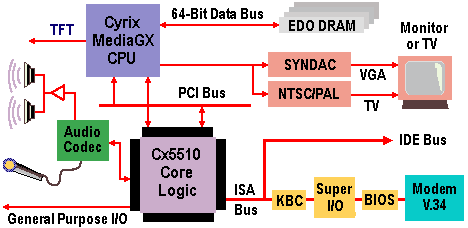The introduction of the MediaGX processor in February 1997 defined the first new PC architecture in a decade, and ignited a new market category – the low-cost Basic PC. The growth of this market proved to be been explosive, and Cyrix’s processor technology and system-level innovation a critical component.
The more processing that occurs on a PC’s CPU itself, the more efficient the overall system performance. In traditional computer designs, the CPU processes data at the megahertz of the chip, while the bus that moves data to and from other components operates at only half that speed, or even less. This means that data movement to and from the CPU takes more time – and the potential for data stalls increases. Cyrix eliminated this bottleneck with MediaGX technology.
The MediaGX architecture integrates the graphics and audio functions, the PCI interface and the memory controller into the processor unit, thereby eliminating potential system conflicts and end-user configuration problems. It consists of two chips – the MediaGX processor and the MediaGX Cx5510 companion chip. The processor uses a propriety socket requiring a specially designed motherboard.
The MediaGX processor is a x86-compatible processor which directly interfaces to a PCI bus and EDO DRAM memory over a dedicated 64-bit data bus. Cyrix claims that the compression technique used over the data bus obviates the need for a Level 2 cache. There is 16KB unified Level 1 cache on the CPU – the same amount as on a standard Pentium chip.
Graphics are handled by a dedicated pipeline on the CPU itself and the display controller is also on the main processor. There is no video memory, the frame buffer being stored in main memory without the performance degradation associated with traditional Unified Memory Architecture (UMA), using instead Cyrix’s own Display Compression Technology (DCT). VGA data operations are handled in hardware, but VGA registers and controls are controlled through Cyrix’s Virtual System Architecture (VSA) software.

The companion chip, the MediaGX Cx5510, houses the audio controller and again uses VSA software to mimic the functionality of industry standard audio chips. It also provides the bridge to the ISA bus and IDE and I/O ports. It bridges the MediaGX processor over the PCI bus to the ISA bus and interfaces to the IDE and I/O ports and also performs traditional chipset functions.
After its acquisition by National Semiconductor in November 1997, the new company reasserted its intention to compete with Intel and to focus on driving down the price of PCs by continuing to develop its PC on a chip Media GX technology. By the summer of 1998 MediaGX processors, based on 0.25-micron fabrication, had reached speeds of 233MHz and 266MHz, with higher speed grades expected by the end of the year.
In fact, with parent National Semiconductor in financial difficulty, the MediaGX faced increasing pressure from Intel’s and AMD’s budget chips, which also continued to get less expensive while offering much greater performance. As a consequence, the MediaGX – which had been considered a performance product in 1996 – found itself in danger of completely losing its market as it was progressively relegated to the mid-range, then the entry level and finally to the fringe of the entry level.